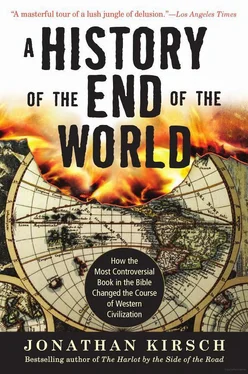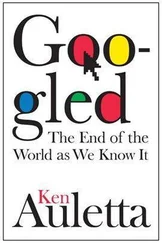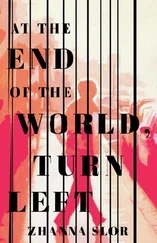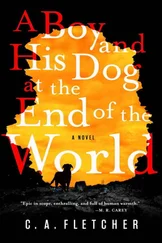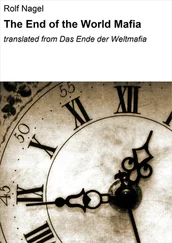But On the Beach is not a restaging of Revelation in modern dress, and neither God nor the Devil is given a role in the end of the world. Rather, blame is placed solely and squarely on human beings: “The whole damned war was an accident,” explains a scientist, played by an aging and world-weary Fred Astaire, who is poisoned with remorse over his role in the design of atomic weaponry long before he faces the prospect of death by radiation sickness. “In the end, somehow granted time for examination, we shall find that our so-called civilization was gloriously destroyed by a handful of vacuum tubes and transistors.” And then he adds in a bitter aside: “Probably faulty.”
God is invoked only twice in On the Beach, and only rhetorically. A Salvation Army preacher delivers a final sermon to a sparse crowd that gathers on the street where government-issue suicide pills are being handed out. “O Lord, give us strength,” he intones. “Help us to understand the reason for this madness on earth, the reason why we have destroyed ourselves.” 1And an earnest young naval officer, played by Anthony Perkins, reflexively invokes the deity while anguishing over his fatherly duty to administer a dose of poison to his infant daughter when the first symptoms of radiation sickness appear: “God,” he mutters, “God forgive us.”
Indeed, On the Beach strays from apocalyptic tradition in both Judaism and Christianity for the simple reason that the movie holds out no hope for survival even by a few saints and martyrs: everyone on earth will surely die, whether by suicide or by radiation sickness, and history will come to an end, final and unredeemed. Indeed, that’s what distinguishes On the Beach from most of the other books and movies of the postwar era in which the story line focuses on the undaunted survivors. One of the most affecting moments, in fact, is the scene in which the young naval officer, having already administered a fatal dose to his baby, prepares a cup of poison-laced tea for his negligee-clad wife. So far, she has refused to accept the fact that the world will end, but now she is resigned to her fate: “Darling, I’m ready for my tea” are her last words, a coded expression of utter hopelessness and helplessness.
Here, then, is a God-less apocalypse in which human beings have no one to blame except themselves—and, crucially, no one to whom they may turn for rescue or redemption. The point is made in the last frame of On the Beach, where we see for a second time the inspirational banner that was previously displayed at the Salvation Army rally. The banner, now tattered and windblown, flies over a street that is utterly devoid of human life, and its encouraging message is shown to have been wholly and tragically wrong: “THERE IS STILL TIME, BROTHER.” 2
Even if the Apocalypse according to Hollywood allows no role for God, the fact remains that On the Beach carries a few strands of the theological DNA that can be found in Revelation and Daniel. Some of the same shocks and thrills that men and women once found in altarpieces or block prints of an earlier age—Michelangelo’s scenes of the Last Judgment on the ceiling of the Sistine Chapel, for example, or Dürer’s illustrated edition of The Apocalypse of St. John— are now displayed and contemplated on the silver screen. All of these products of the human imagination, from Daniel and Revelation to the latest apocalyptic movie or miniseries, ask the same old and scary questions: When and how will the world come to an end, and what will happen next?
On the Beach is perhaps the single most despairing expression of an apocalyptic state of mind that seized the American imagination in the 1940s and 1950s—“the postwar ‘doom boom,’” according to Stephen D. O’Leary, a scholar and critic who specializes in the study of the apocalyptic idea in modern politics and popular culture. 3Rather than avenging archangels like Gabriel and Michael, however, the celestial figures in the pop-culture version of the end-times are men from Venus or Mars, and instead of the satanic beasts of Revelation, the monsters are reptilian creatures like Godzilla or mutant insects like the oversize ants in Them. But it is also true that apocalyptic science fiction is concerned with exactly the same hopes and fears that are addressed in the book of Revelation—and, like Revelation (but unlike On the Beach ), most of the books and movies that imagine the end of the world also imagine a New Heaven and a New Earth in which the Elect will survive and thrive.
“Science fiction films are not about science. They are about disaster, which is one of the old subjects of art,” observes critic and cultural observer Susan Sontag in her essay “The Imagination of Disaster.” “[S]cience fiction allegories are one of the myths about—that is, one of the ways of accommodating to and negating—the perennial human anxiety about death. (Myths of heaven and hell, and of ghosts, had the same function.)” 4
Significantly, God appears not at all in the bulk of apocalyptic science fiction in the postwar era. Even Deus Irae, by Philip K. Dick and Roger Zelazny, a theologically sophisticated novel about the quest for God by the limbless survivor of a nuclear holocaust, ends with the shattering revelation that the “God of Wrath” whom he seeks is, in fact, the government scientist who devised “the evil instruments which had shown up the ‘God’ of the Christian Church for what he was”—that is, an impotent if not wholly imaginary deity. 5
“The final enemy which Paul had recognized—death—had had its victory after all; Paul had died for nothing,” write Dick and Zelazny, referring to the biblical apostle. “Death was not an antagonist, the last enemy, as Paul had thought; death was the release from bondage to the God of Life, the Deus Irae. In death one was free from Him—and only in death.” 6
Salvation in apocalyptic science fiction, when it is available at all, comes not from God but from human beings. The title of The Omega Man, of course, refers obliquely to the book of Revelation (“I am the Alpha and the Omega, the first and the last”), but the hero of the movie is a mortal man, played by the ruggedly handsome Charlton Heston, who manages to defeat the deformed and slightly demonic survivors of a catastrophic biological war only because he possesses a submachine gun, an electrical generator, a supply of gasoline, and a laboratory where he succeeds in concocting a cure for the plague that killed or maimed everyone else on earth. The movie ends with a distinctly Christological image—the character played by Heston, struck down by a spear, dies in the posture of Jesus on the cross—and the last hope for the survival of humankind is a flask of his own blood, but only because it contains the vital antibodies that will preserve the lives of the rest of the survivors.
“Christ, you could save the world,” says one of the hopeful survivors to the thoroughly human savior, and one of the last children on earth asks: “Are you God?” 7
The same theme—scientist as savior—could be discerned among fleshand-blood scientists who felt themselves called to a kind of secular prophecy in the postwar world. The Bulletin of Atomic Scientists, for example, devised the so-called “Doomsday Clock” as a consciousness-raising device to call the attention of politicians, generals, and the citizenry to the deadly implications of nuclear proliferation. But the Doomsday Clock, an icon of the Cold War era, played on the same anxieties that have afflicted the human imagination since biblical antiquity: “Like the first followers of Jesus and John the Baptist,” observes Stephen D. O’Leary, “the scientists who attempted to enter the political arena in the late 1940s were animated by the urgent conviction that time was short and destruction was sure unless our course could be changed.” 8
Читать дальше
